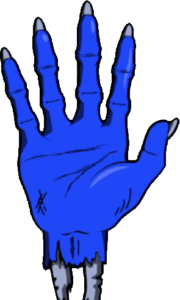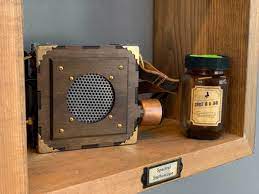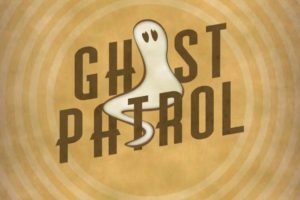
Room Type: Tech (Sci-Fi) Rating: 5 / 5

Review by Michael Merriam
The sole offering of Emeryville’s “Trivium” venue deserves its many awards, and the room’s name is only slightly misleading (it’s not a special division of a government force, it’s fortunately more literal and silly and fun than that). Don’t worry if you don’t like horror, it’s about funny ghosts, in the tradition of Mark Twain or Oscar Wilde.
It’s going for (and achieves) a Ghost and Mr. Chicken vibe, and the house does feel haunted, especially because it doesn’t overdo it with gothic scenery or a “mansion” setting. They also found a gentle, giggle-inducing analogue to the jump scare, with the happy lighting and music cues that move you spookily along. Like Ghostbusters, it’s the science-fiction elements that make Ghost Patrol amusing, but unlike Ghostbusters, the sci-if takes over. This never feels wrong, but it’s something to be aware of — this is in the category of “Tech”, and it’s decidedly in the dark-blue zone of Partly Wicked’s color-coding system. That’s not meant to do anything but help designers decide what they might be able to learn from Ghost Patrol, or which of their projects it could inspire them to improve. The color-coding system also lets people know what sort of social situations or people the room will most appeal to. I’ve always said Tech rooms appeal to a fantasy of competence (rather than power, or transportation to an exotic locale). There were times I felt inadequate and… well, dumb, compared to my teammates, but the room also gave me (and everyone else) opportunities to shine.

Room Type: Tech (Sci Fi) — Rating: 5 / 5
This is a quirk of “tech” based escape rooms, which are probably more related to toddlers’ busy boards than to science fiction. The “tech” dimension is where this room succeeds, and it’s also where most rooms like Ghost Patrol fail. I was not any smarter after Ghost Patrol than before, but I felt smarter. Particularly when I figured out how to make a gizmo work, and was able to prove I was right by making it work, the product of which was an object that another player needed.
Did all the machines make us feel heroic in our impromptu competence, using (rather than just “getting past”) technology we’d usually need credentials or experience to operate? Yes. So successfully that designers should play Ghost Patrol just to experience and analyze its use of imaginary machines. On reflection, I think it succeeds here largely because the puzzle-elements feel activated once the Eureka moment happens, once the player is struck with an idea about how it works. Because they let the player solve most of it solo, players get to test and confirm their hypothesis before showing off — and even better, the room makes players show off, whether they’d normally do that or not. In the last moments before each tech0based challenge is solved, it demands that one or two teammates join in, just for a moment. Therefore, the clever player who already figured it out has to teach it to the rest of the team, and this phase is just long enough for everyone to see the solver’s success. Even better, the machine then produces a physical object that everyone will physically need, all thanks to the clever player who figured out how to work the contraption. (And there’s an abundance of these gizmos). The ultimate result is that, instead of causing a door to open (or whatever) and hoping someone will say “I’m so impressed you made that happen, how ever did you manage it?”, teammates will have directly experienced the fact that the solver is very, very smart. And if that’s not at least part of what escape rooms are for, what good are they?
Everyone got a couple of moments like that, in the 90 minutes of Ghost Patrol. I enjoyed feeling smart (if only temporarily, like the mouse in Flowers for Algernon) but I’m equally glad that I learned just how brilliant — and irreplaceable — my teammates were. We were all congratulating each other afterward, adding the golden proviso that marks profoundly successful escape room design: everyone told everybody else, individually, that if that person hadn’t been there, we probably wouldn’t have made it out.
If a designer does choose to model their tech-based puzzles after the ones in Ghost Patrol, they they’ll know they’ve succeeded if the solver is not only able, but eager to pass solution on to other players. That means there’s a consistent logic, a sense of the machine being “operated” rather than solved). By including a phase where the teammates must be the solver’s audience (and by keeping that phase brief) a designer can pull of what Ghost Patrol pulls off, and make its visitors feel not only that they are brilliant, but that someone finally noticed.
I really do think the means of incorporating tech is the less obvious reason Ghost Patrol has earned so much praise. The more obvious reason is the deliciously real and inviting set design and theming. Both are introduced at once, in a clever element that ensures immersion on the player’s own terms. A mid-century (steampunk-adjacent) piece of tech, like something from a Ghostbusters prequel set in the 1940s, a clunky old jalopy of an ectoplasm-amplifier, worn around the neck, so that one team member touches it to any traces of ectoplasm they might find, causing echoes from the past or other aural cues to issue from the speaker box.
 In fact, all hints and even facts as bare as the room’s timer are delivered with context-appropriate aesthetics. Integrity of immersion seems like the venue’s most respected value. We never had to use the intriguingly antique telephone in the haunted house (which would have linked us to our game master, who would have given us a hint) but the personality of all clues and guiding design elements felt plausible and in-character for the funny haunted laboratory 50s matinee we were all starring in. Ghosts have given hints throughout all literature, but it’s hard to buy into that when they needlessly talk in riddles, like the baseball team from Field of Dreams. The ghost(s) in Ghost Patrol would clearly love to just come out and say it, but it’s also clear that they have to make do with Poltergeist Charades: appliances that turn on by themselves, disembodied knocking, and, when they want to say “FINALLY” or “THANK YOU” when we make substantial progress, they can only play some music and make the lights dance as if celebrating. These elements become the spectre’s voice and body, and there’s a puppetry to it that’s as uncannily real as a Sesame Street monster in the first half hour, but which (pardon the expression) deadens and becomes less lifelike later on.
In fact, all hints and even facts as bare as the room’s timer are delivered with context-appropriate aesthetics. Integrity of immersion seems like the venue’s most respected value. We never had to use the intriguingly antique telephone in the haunted house (which would have linked us to our game master, who would have given us a hint) but the personality of all clues and guiding design elements felt plausible and in-character for the funny haunted laboratory 50s matinee we were all starring in. Ghosts have given hints throughout all literature, but it’s hard to buy into that when they needlessly talk in riddles, like the baseball team from Field of Dreams. The ghost(s) in Ghost Patrol would clearly love to just come out and say it, but it’s also clear that they have to make do with Poltergeist Charades: appliances that turn on by themselves, disembodied knocking, and, when they want to say “FINALLY” or “THANK YOU” when we make substantial progress, they can only play some music and make the lights dance as if celebrating. These elements become the spectre’s voice and body, and there’s a puppetry to it that’s as uncannily real as a Sesame Street monster in the first half hour, but which (pardon the expression) deadens and becomes less lifelike later on.
This is the tiniest of gripes. But since I’m critiquing Ghost Patrol as a masterpiece we should talk about for decades (which it is), we should talk about how the ghost’s personality subsides, not because it left the story, but because the little touches of end to-puppetry, like the half-hesitant flickers and sense of eagerness that made us want to shout, “Casper, is that you?” In the first half of our adventure went away. It started to seem like the escape room, venue was showing us what to do next, rather than the ghost doing whatever it could to get us to the next challenges. In much later phases, when we should have been reading the diagrams and lab notes bearing the ghost’s personality in mind, we’d mostly forgotten it was there with us, and that made some of the end-game look more illogical than it really was. Even if this was intentional, it’s something the venue might consider fixing by making the moments when the ghost is “talking” to us feel a little messier, a little more improvised and a little less designed. If the ghost’s personality was more obvious in the brilliant clue-delivery system of the game’s second half, the solutions would seem more natural. Because the puppetry of the ghost’s “voice” became less life-like, it sometimes seemed like the machine was providing hints and feedback that machines just don’t provide, replacing the sense of cooperation with the more beleaguered “escape rooms are just like that, let it go” that’s still par for the medium.
None of that matters from a consumer’s perspective, though. I was just ruminating on ER aesthetics, and how they help immersion, or hinder it. Even the weakest puzzle in Ghost Patrol (if there are any weak ones) is many times more plausible, immersive, and appropriately challenging than any find-the-number padlock game out there. It’s 90 minutes, 4-person minimum, and you bring the kids. Especially the smart ones.

Read more posts in the category:
Review / San Francisco
More posts from:
March 2023 / All of 2023